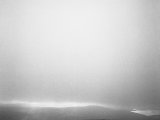Na Zemi vzhůru nohama
2015
Projekt Na pomezí samoty, Finmark, Norsko. Fotografie, video.

Na Zemi vzhůru nohama
Gal dan oažžu jáhkkit, gii dáhttu
Kdo chce věřit, uvěří *
Cesta vedla na sever. Sever se posouvá. Sever pro obyvatele Osla je někde uprostřed Norska v Trondheimu, pro obyvatele Trondheimu je někde v Altě, v Altě se posouvá ještě dál na sever. Kautokeino. Tam začínala naše expedice, sem ale obyvatel z Osla málokdy dojede.
Tady je země původních „Sami“ a mapa zde je otočená vzhůru nohama. Zde žijí pastevci sobích stád a rybáři, v průměru 0,3 obyvatel na km2. Když jsme se blíže seznámili s jejich historií, kulturou a současnými tradicemi díky přednášce Ola Johana Gaupa, začalo se mi potvrzovat, jak moc je dnešní způsob našeho života vzdálený od jejich počínání. To, co bylo vždy přirozené, nám najednou připadá jako výstřední. Je ti zima? Rozdělej si oheň a přikryj se sobí kůží. Máš hlad? Zabij nejstaršího soba. Máš na něco chuť? Udělej si palačinky ze sobí krve (také jsme ochutnali). Chceš se projít se psem? Běž, ale dej pozor, ať ti psa neodnese orel. A tak dál. Připadám si jako na jiné planetě. Žasnu nad zdejší uvědomělostí a přirozenou ohleduplností k přírodě, která by nám všem měla být vlastní. Zjišťuji, že dokonce i sobi mají tlapy měkké a uzpůsobené tak, že se při nášlapu váha rozloží a rostliny pod jejich vahou se jen lehce ohnou. V tlamě jim navíc chybí přední zuby, takže pokud něco okusují, jemně to jen škubou dásněmi. Tady je příroda milovaná a závislost na ní zřejmá. O to více v kontrastu vyvstává její narušení formou těžebních aktivit, které jsou drastickým zásahem do původního prostředí. Krajina opuštěných dolů v Kautokeino připomíná krajinu jiné planety, na které se s životem už nepočítá.
Střih. Brázdíme sever severu až do jednoho z posledních míst naší expedice, do Kirkenes na hranicích s Ruskem. Cestou nejmodernějších technologií se v této oblasti těží železná ruda, ropa i zemní plyn. Jako odpad z tohoto bohatství se ročně v průměru 2 miliony tun toxického odpadu „nenápadně“ vyváží na dno moře. Nejen na zemi, ale i pod mořskou hladinou je krajina v důsledku těžby vzhůru nohama. Z jámy v dole je hora, hora odpadu přemístěná na dno moře. Kontaminovaná fauna a flora. Proč to nikdo nezastaví? Znova žasnu nad tím, jak se na původní vztah k přírodě dokáže zapomenout. Připadám si opět jako na jiné planetě, na planetě převrácených vzorců chování.
Nedaleko odtud v Games, rozsáhlé oblasti poblíž letiště v Kirkenes, se rozhodla těžební společnost Nor Terminal zahájit těžbu ropy a plynu. Při prvních výkopech se však nečekaně objevily prehistorické rytiny na kamenech a těžba musela být pozastavena. Že by se planeta svým vlastním pudem sebezáchovy začala bránit? Vyvstává napínavá otázka: můžou prehistorické obrazy zastavit těžbu? Kéž by se dalo umění použít jako obranná zbraň.
Sérii fotografií a vidosekvence je přímo inspirovaná touto problematikou a motivem „otočení“ a představuje vztah člověka k Zemi jakoby pohledem mimozemšťana. Jednotlivé záběry skládají dohromady mozaiku z různých míst na severu Norska, poukazují na detaily i krajinné celky. Jednotlivé záběry neodkazují přímo ke konkrétním lokalitám, ale v obecnější rovině představují pohled na Zemi v módu převrácené hierarchie hodnot, přepólování těžišť zájmů. Důležitým aspektem při přípravě vizuálního výstupu je otázka času ve smyslu délky trvání a dočasnosti – krajina je utvářena v dlouhé době, a tato doba ovlivnila vztahy člověka k ní. Navzdory tomu jiný člověk zachází s krajinou takovou silou a s tak krátkodobými cíly, jakoby šel mílovými kroky proti času.
Název expedice Na pomezí samoty pro mě po jejím absolvování nabyl nového významu – ocitla jsem se na hranici zlomu časoprostoru – původní člověk zůstal stát a krajina kolem byla posunuta v prostoru i v čase. Fotografická série a videosekvence je pro mě ideálním prostředkem, jak převracení, plynutí a zastavení času zachytit.
Jođi lea buoret go oru
Čas je loď, která nikdy nekotví *
* z publikace Jođi lea buoret go oru – Sátnevádjasat, Harald Gaski (ed.), ČálliidLágádus, 2003. (Přísloví Samiů shromážděné J. Qvigstadem, 1922).
Alena Kotzmannová










